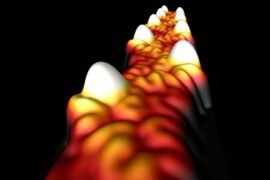In the physics laboratories of complex systems and the physics of condensed matter at the Weizmann Institute, an extraordinary phenomenon was discovered that, according to the researchers, may in the future lead to the development of much faster electronic systems than the existing ones.
Speed is the name of the game in the research group of Prof. Nirit Dudowitz from the Department of Physics of Complex Systems at the Weizmann Institute of Science. The members of the group examine ultra-short phenomena in nature, using flashes of light whose speed is measured in atomic seconds (atomic-second is the billionth of a billionth of a billionth). These brief flashes of light allow scientists to examine various quantum processes, from quantum tunneling to the decomposition or incorporation of molecules into certain chemical reactions. Until recently, these advanced studies and experiments have been performed on the material in a gaseous aggregation state. Then the research students Ayelet Ozen and Gal Orenstein entered Prof. Dudowitz’s laboratory. They suggested trying to create the fast flashes of light in a solid material. A substance in a gaseous state of aggregation consists of separated atoms, with each atom having a small number of electrons, centered around the nucleus. In contrast, a crystal of solid matter consists of a great many atoms arranged together and a huge amount of electrons scattered throughout the crystal.
Such experiments, in solid material, have already been carried out in some laboratories in the world. Since this is an experimental and theoretical challenge, which requires a significant change in the direction of her research, Prof. Dudowitz was debating whether to choose to move in this direction. Still, the enthusiasm of the research students swept her away, and they began to design and build the experiment, in collaboration with Prof. Binghai Yan and members of his group from the Department of Condensed Materials Physics at the Institute.
The first experiments led to results that scientists called “strange.” And here it may be worth remembering that the scientist and science fiction writer, Isaac Asimov, said that “the most important expression in science is ‘it’s weird…'”. The strange phenomenon obtained showed that the spectrum of the rapid flashes consists of a quasi-arc of “hills and valleys.” For many months scientists have been trying to figure out what the origin of this special spectral form is and what information can be obtained from it.
The electron, which is a quantum particle, can be in the superposition of quantum states. For example, being simultaneously in several different states characterized by different energy. Scientists have been trying to understand the relationship between these energy levels (the quantum state of the electron) and the spectrum of fast flashes.
The insight, as is often the case, suddenly appeared, when scientists noticed that certain superpositions of the electron form a kind of “lens” that concentrates the emission of short flashes into the “hills” that appear on the measured spectrum.
“The structure of energy levels in a material determines its basic properties,” says Prof. Dudowitz. “In the future, we hope to measure the ability of high-intensity laser light to ‘momentarily’ change the structure of the levels – and thus also the properties of the material. For example we may measure a very rapid change in the properties of the material, which turns from an insulator to a conductor and repeats God forbid. The new understanding we have gained may lead, in the future, to the creation of a new kind of electronics, in which different processes take place at speeds much greater than anything we know today ”.
The new results and insights, as usual, are already setting new ambitions. Prof. Dudowitz’s laboratory is already thinking of ways to produce a dynamic, video-like measurement that will show, in “slow motion”, exactly how the energy levels of the measured electron change, while performing processes whose natural duration is measured in seconds.





